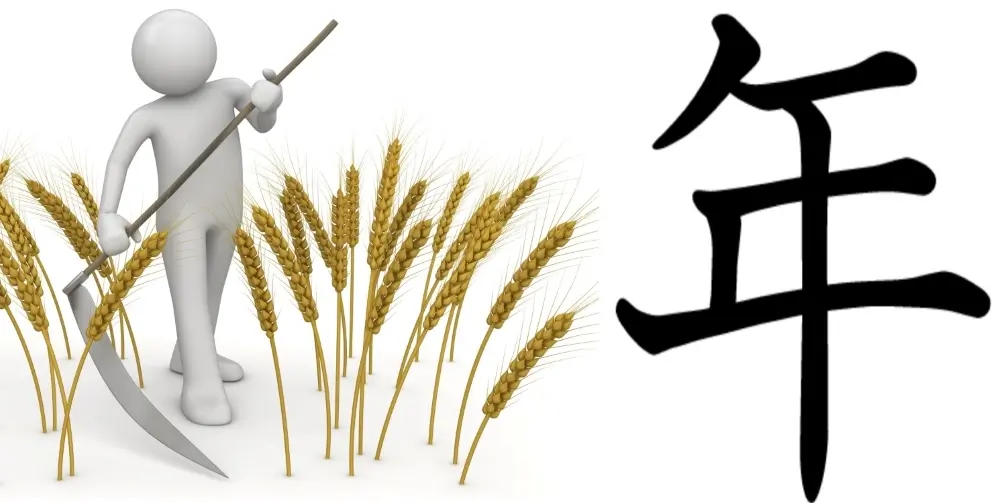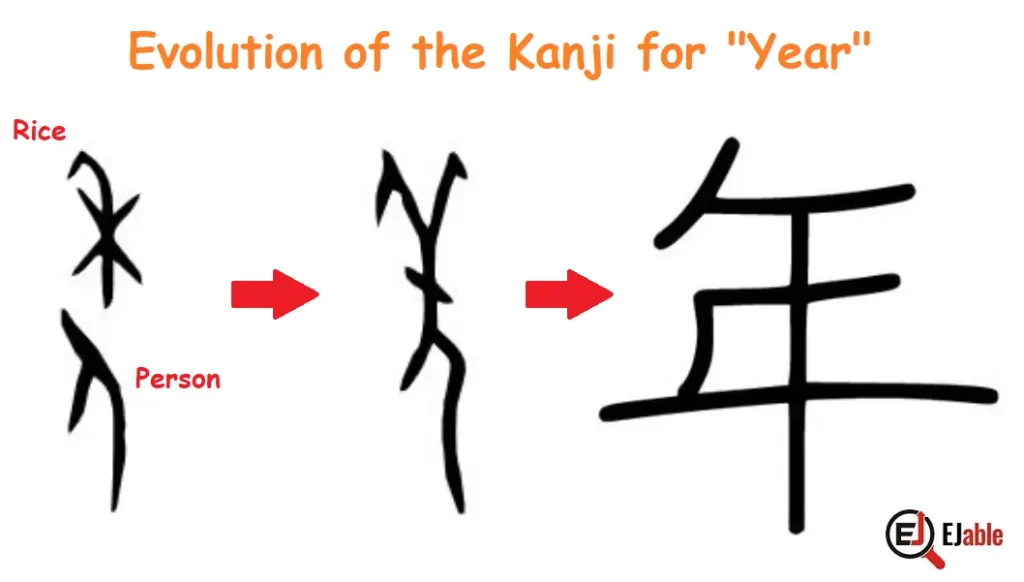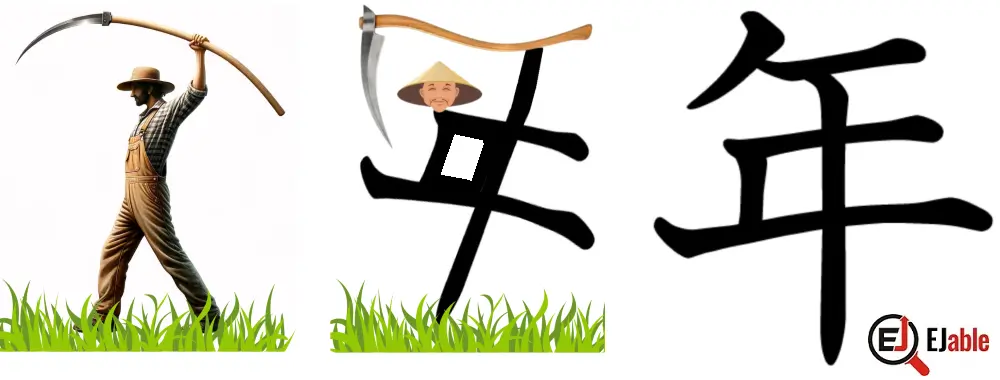Kanji for Year: 年 (Toshi, Nen)

The Japanese Kanji for “year” is 年. The Kunyomi or the Japanese pronunciation of the Kanji 年 is “toshi” (とし), and the Onyomi (Chinese) pronunciation is “nen” (ネン).
Year’s Kanji is part of JLPT N5 (please check the JLPT N5 Kanji list) and is taught in grade 1 in Japanese schools.
Construction and Origin of the Shape 年
The construction of the Kanji 年, meaning year, has 6 strokes and has an intriguing origin, which we will discuss in this article, apart from other must-know aspects of this Kanji.
As we know, all languages and writing scripts came up much before humans had much knowledge and understanding about even our own planet, not to mention the solar system. How we define a year is based on the planetary movements; however, when humans came up with the concept of “year”, they did not know anything about the planetary movements.
So, before going into the origin of the Kanji of “year”, let’s discuss how early civilizations must have come up with the concept of a year while discussing time frames.
Historical Origin of the Concept of “Year”
The concept of a “year” in early civilizations likely arose from observations of the natural world, particularly the cycles of the seasons. Long before understanding planetary movements, early humans noticed recurring patterns in weather, vegetation, and animal behavior. These observations were crucial for survival, especially for agricultural and hunting activities.
- Seasonal Changes: The most evident sign of a passing year would have been the changing seasons. People noticed that certain weather conditions, plant growth, and animal behaviors were cyclical and predictable.
- Agricultural Cycles: Early agriculture significantly influenced the concept of a year. The need to sow seeds and harvest crops at the right times required an understanding of these seasonal cycles.
- Lunar Cycles: Many early societies also observed the moon’s phases. Although a lunar month is shorter than a solar year, the accumulation of lunar cycles was another way to mark longer periods.
- Solar Cycles: Observations of the sun‘s position, particularly solstices and equinoxes, were also crucial. These solar markers were essential for creating more accurate calendars.
These natural cycles provided the fundamental basis for the early understanding of a year before scientific explanations about Earth‘s orbit around the sun were established.
So, Origin of 年 as The Kanji Denoting Year?
Out of the above four phenomena leading to the origin of the concept of a year, the first two are the most basic as they relate directly to our lives. Out of these two, i.e., seasonal changes and hence the agriculture cycles, the latter is directly linked to survival. Therefore, it is no surprise that “year” was associated with agriculture.
Rice has always been the number one agricultural produce of both China and Japan, and the origin of the Kanji of “year” was to depict the annual harvesting of rice.
The original shape of the Kanji for “Year” in the Oracle Bone Script and Bronze Scription depicted a person with a rice plant at the top, as illustrated in the following picture:

Mnemonic: How to Remember the Kanji for Year (年)
Year’s Kanji is one of those Kanji characters that evolved dramatically over time, and it’s hard to remember it by thinking about its origin. Therefore, the following illustration will serve the purpose of a mnemonic to remember it quickly:

Explanation
In the above illustration, the upper part of 年 can be imagined as a scythe, used in harvesting, symbolizing the end of a yearly agricultural cycle. The lower part of the Kanji can be imagined as the farmer holding the scythe to harvest rice.
Year (Toshi/Nen) Kanji in Compounded Words
Kanji of the Year 年 is frequently used in other compounded Kanji characters. However, the Kanji 年 does not have a radical and also does not appear as a component in other Kanji characters.
There are 252 Japanese words that begin with the Kanji 年, and it appears in 761 words.
Examples of Kanji 年 in Compounded Kanji Characters
Following are the examples where Kanji for year appears in Japanese compounded Kanji characters:
- 今年 (ことし / kotoshi): This year.
- 去年 (きょねん / kyonen): Last year.
- 来年 (らいねん / rainen): Next year.
- 年末 (ねんまつ / nenmatsu): Year-end.
- 年始 (ねんし / nenshi): Beginning of the year.
- 年代 (ねんだい / nendai): Decade, era.
- 年中 (ねんじゅう / nenjū): All year round.
- 年齢 (ねんれい / nenrei): Age.
- 年次 (ねんじ / nenji): Annual.
- 年会 (ねんかい / nenkai): Annual meeting.
- 年金 (ねんきん / nenkin): Pension, annuity.
- 年度 (ねんど / nendo): Fiscal year.
- 年表 (ねんぴょう / nenpyō) – Chronological table.
- 年生 (ねんせい / nensei): Year student (e.g., 一年生 for first-year student).
- 年率 (ねんりつ / nenritsu): Annual rate.
These compound Japanese words demonstrate the varied use of the Kanji 年 in year-related contexts, such as chronological periods, annual events, and age.
Check other Kanji characters on the page “How to Remember Kanji“. You may also like to read about the common Kanji radicals.

A long-term ex-pat in Japan, Himanshu comes with an IT background in SAP consulting, IT Business Development, and then running the country operations of an IT consulting multinational. Himanshu is the co-founder and Managing Director of ReachExt K.K. and EJable.com. He is also an Advisory Board Member of a Silicon Valley AI/IoT startup.
